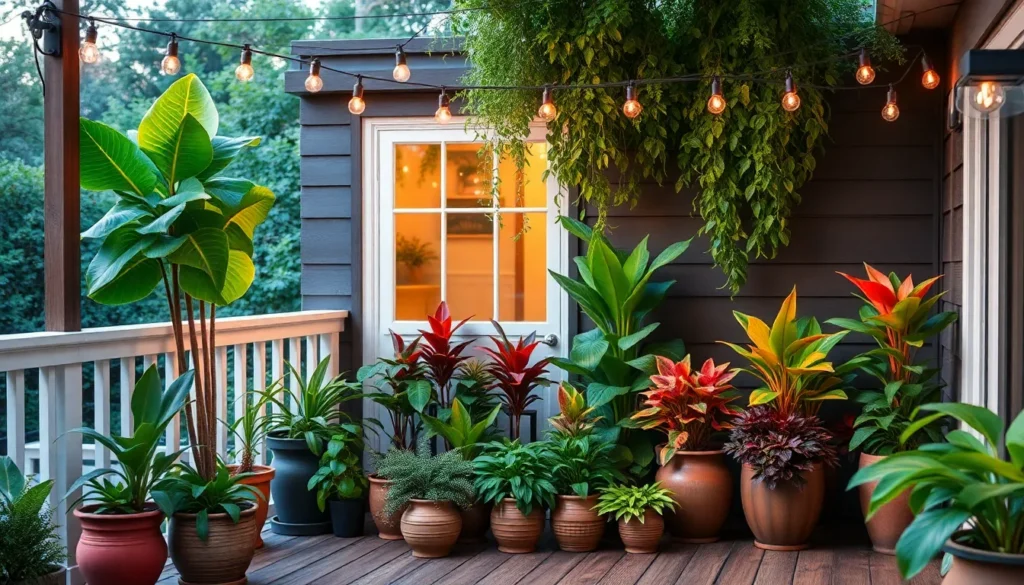We’ve all admired those stunning outdoor spaces that seamlessly blend nature with thoughtful design. The secret? Houseplants used as outdoor decor create magical transformations that’ll make your neighbors stop and stare.
Moving your beloved houseplants outdoors isn’t just about giving them fresh air – it’s about creating an outdoor oasis that extends your living space beyond four walls. Whether you’re working with a sprawling backyard deck or a tiny apartment balcony we’re here to show you how the right plant placement can turn any outdoor area into a Pinterest-worthy retreat.
The beauty of using houseplants for outdoor decoration lies in their versatility and the instant impact they create. From cascading pothos draping over railings to statement fiddle leaf figs anchoring cozy seating areas these green companions bring life color and personality to spaces that might otherwise feel flat or uninviting.
Create a Seamless Indoor-Outdoor Plant Transition
Blending your indoor plant collection with outdoor decor creates a cohesive flow that makes both spaces feel larger and more connected. We’ll show you how to achieve this harmonious transition using strategic plant choices and design techniques.
Choose Plants That Thrive in Both Environments
Selecting versatile houseplants ensures your decor investment works year round in multiple locations. Snake plants, ZZ plants, and rubber trees adapt exceptionally well to changing light conditions and can move seamlessly between indoor and outdoor settings. Pothos varieties like golden pothos and marble queen handle both filtered indoor light and bright outdoor shade with remarkable resilience.
Tropical houseplants often perform best in this dual role since they naturally prefer outdoor conditions during warmer months. Monstera deliciosa, peace lilies, and Boston ferns thrive outdoors in summer temperatures while maintaining their indoor beauty during cooler seasons. These plants develop stronger growth patterns and more vibrant foliage when they experience periodic outdoor exposure.
Consider your climate zone when selecting plants for indoor outdoor transitions. Hardy options like jade plants, aloe vera, and spider plants tolerate temperature fluctuations better than sensitive varieties. We recommend starting with proven adaptable species before experimenting with more delicate houseplants in your outdoor decor arrangements.
Match Indoor and Outdoor Plant Color Schemes
Coordinating foliage colors creates visual continuity that ties your indoor and outdoor spaces together effortlessly. Silver dusty miller outdoors pairs beautifully with indoor silver pothos, while deep green outdoor hostas complement your indoor snake plants and ZZ plants. This color matching technique helps establish a cohesive plant palette throughout your entire living environment.
Repeating exact leaf shapes and textures reinforces the connection between your indoor houseplants and outdoor plant decor. Broad leafed plants like fiddle leaf figs indoors can echo with outdoor elephant ears or caladiums. Spiky textures from indoor aloe plants coordinate perfectly with outdoor agave or yucca plants in your industry design.
Flowering houseplants offer seasonal color coordination opportunities with your outdoor garden beds. African violets, begonias, and cyclamen can match or complement your outdoor annual flower colors. We suggest choosing 2-3 main colors and repeating them in both your indoor houseplant collection and outdoor planted areas for maximum visual impact.
Use Consistent Planter Materials and Styles
Matching planter materials throughout indoor and outdoor spaces creates immediate visual harmony in your plant decor. Terracotta pots work beautifully both inside homes and on patios, while modern concrete planters suit contemporary indoor outdoor design schemes. Natural materials like woven baskets and wooden planters bridge the gap between indoor coziness and outdoor natural elements.
Scale your planter sizes appropriately for each environment while maintaining style consistency. Large statement planters with fiddle leaf figs indoors can pair with similarly sized outdoor planters containing small trees or large shrubs. Medium sized matching planters work perfectly for both indoor houseplants and outdoor herb gardens or annual displays.
Consider weather resistance when selecting planters that will transition between indoor and outdoor use. Glazed ceramic pots handle both environments well, while untreated wood planters may deteriorate quickly outdoors. We recommend investing in high quality planters that can withstand outdoor elements while maintaining their aesthetic appeal indoors throughout the year.
Design Eye-Catching Outdoor Plant Arrangements
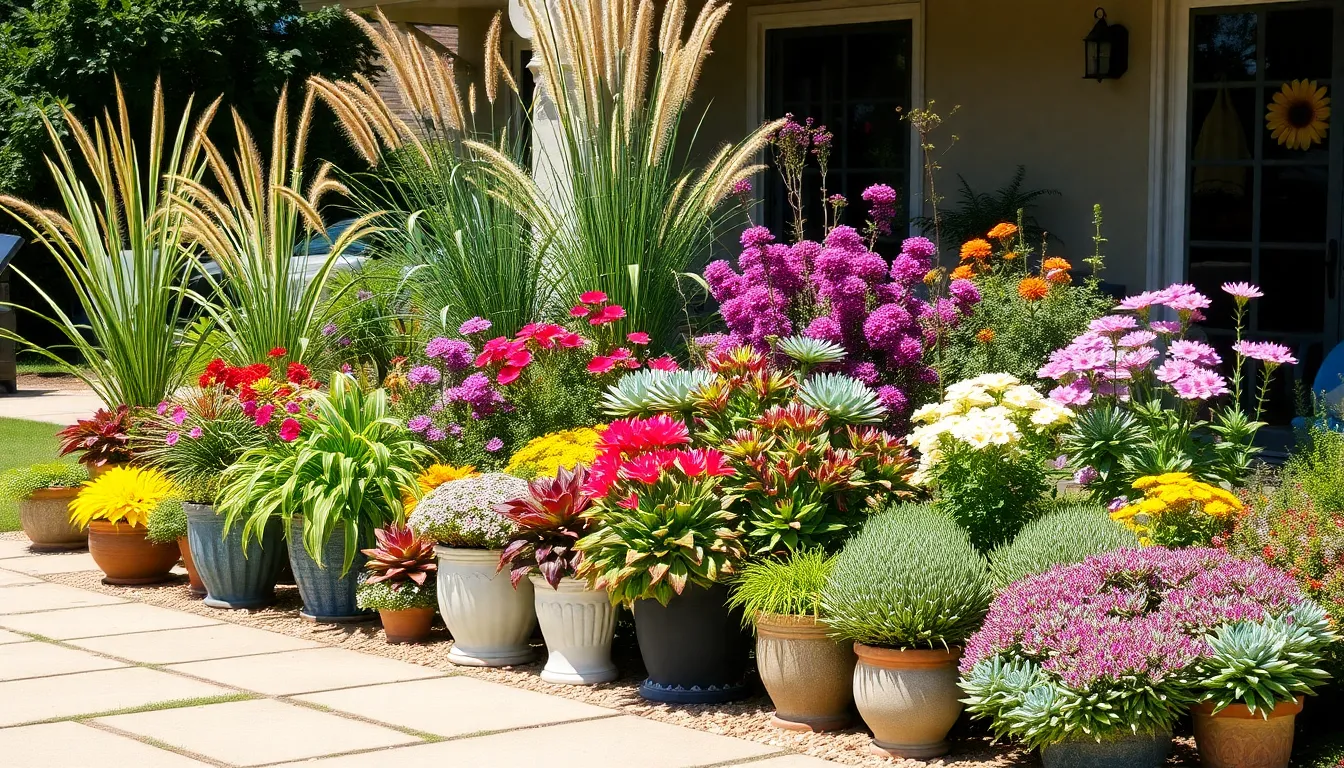
We’ll transform your outdoor space into a stunning plant paradise using strategic design principles that create visual impact and lasting appeal.
Layer Plants by Height and Texture
Layering plants by varying heights creates dramatic depth that draws the eye through your outdoor arrangement. We recommend placing tall plants or climbing varieties as your backdrop, positioning medium sized specimens in the center, and filling the foreground with ground covers or trailing plants. Different foliage types mixed throughout this tiered system add essential textural contrast that prevents your arrangement from appearing flat or monotonous.
Ground level succulents paired with mid height flowering perennials and towering ornamental grasses create natural viewing layers. Leafy greens combined with spiky textures, broad leaves, and delicate fronds establish visual rhythm throughout your display. This strategic placement ensures every plant gets noticed while contributing to the overall composition.
Create Focal Points with Statement Plants
Statement plants serve as anchor points that immediately capture attention and establish your arrangement’s personality. Red Rooster Grass with its distinctive rust colored blades makes an exceptional focal point for contemporary outdoor spaces. Star Jasmine provides both visual appeal and sensory enhancement through its fragrant climbing nature.
Container grown trees like Meyer Lemon trees add impressive height near entryways while remaining manageable in smaller outdoor areas. These specimen plants work best when positioned strategically to draw the eye toward key viewing areas. Bold architectural plants or uniquely colored varieties ensure your arrangement has memorable focal elements that guests notice first.
Incorporate Seasonal Color Changes
Seasonal color transitions keep your outdoor plant arrangements ever-changing and captivating throughout the year. Spring flowering branches provide early season excitement, while ornamental grasses deliver summer and fall interest with their changing textures and colors. Evergreen foliage maintains structure and appeal during winter months when other plants go dormant.
Regular refreshing through seasonal blooms and changing decorative pots prevents your arrangements from becoming stagnant. Plants that naturally shift colors create automatic seasonal updates without requiring complete replanting. This approach ensures your outdoor plant decor remains vibrant and relevant as seasons change, providing year round visual interest that complements your home’s exterior.
Select Weather-Resistant Containers for Outdoor Display
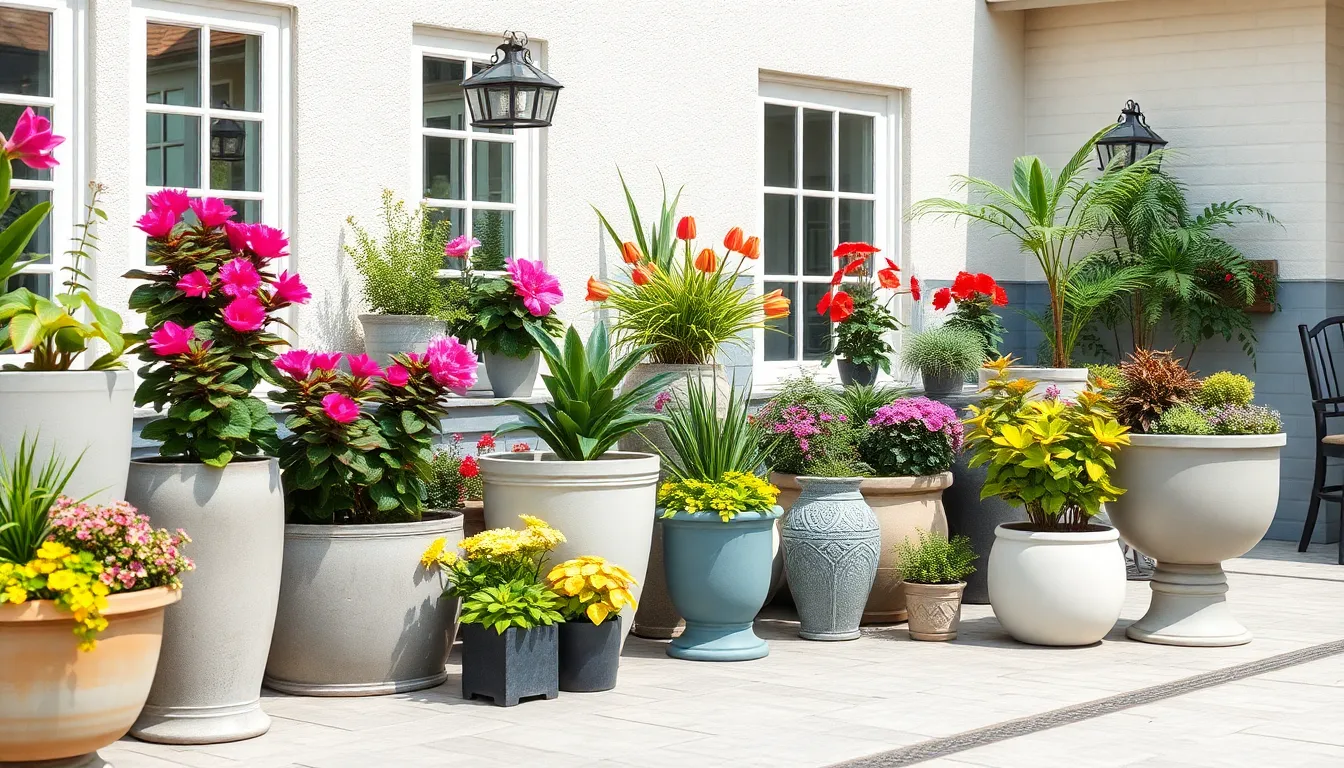
Outdoor planters face constant exposure to sun, rain, frost, and temperature fluctuations that can damage inferior materials. We need containers that’ll maintain their beauty and structural integrity through all seasons while protecting our houseplants from climate stress.
Choose Durable Materials Like Ceramic and Stone
Stone planters offer exceptional longevity and resist UV damage that can fade or crack other materials over time. These classic containers provide excellent insulation for plant roots during temperature swings and handle extreme weather conditions without deterioration. Ceramic planters deliver similar durability benefits while offering more decorative options and color choices for our outdoor displays.
Concrete containers combine strength with decorative appeal, making them ideal for permanent outdoor installations where stability matters most. Fiberglass planters provide lightweight durability that’s perfect when we need weather resistance without the heavy weight of traditional stone options. Steel planters bring modern aesthetics to outdoor spaces while offering rust resistance when properly treated.
Ensure Proper Drainage for Plant Health
Drainage holes prevent waterlogging that can kill plant roots and create fungal problems in our outdoor containers. We should verify that every planter has adequate drainage openings at the bottom, especially since outdoor plants receive unpredictable rainfall amounts. Container designs that allow excess water to escape easily become essential in rain prone areas where standing water poses constant threats.
Elevated planters or those with built in drainage systems work particularly well for areas that experience heavy seasonal rains. Adding drainage materials like gravel or pottery shards to container bottoms creates additional water flow even when drainage holes exist.
Consider Size and Weight for Seasonal Moving
Container weight directly impacts our ability to rearrange outdoor displays as seasons change or weather conditions require plant protection. Lightweight materials like fiberglass and resin make seasonal relocation manageable while still providing necessary durability for outdoor conditions. Heavy materials like stone and concrete offer superior stability but limit our flexibility for moving plants to protected areas during harsh weather.
Plant size requirements must balance with container mobility needs when selecting outdoor planters for our houseplant displays. Large statement plants need substantial containers for root health, but we can choose lighter materials to maintain some portability options. Medium sized containers often provide the best compromise between plant health, visual impact, and seasonal flexibility for most outdoor houseplant arrangements.
Incorporate Lighting to Highlight Your Plant Decor
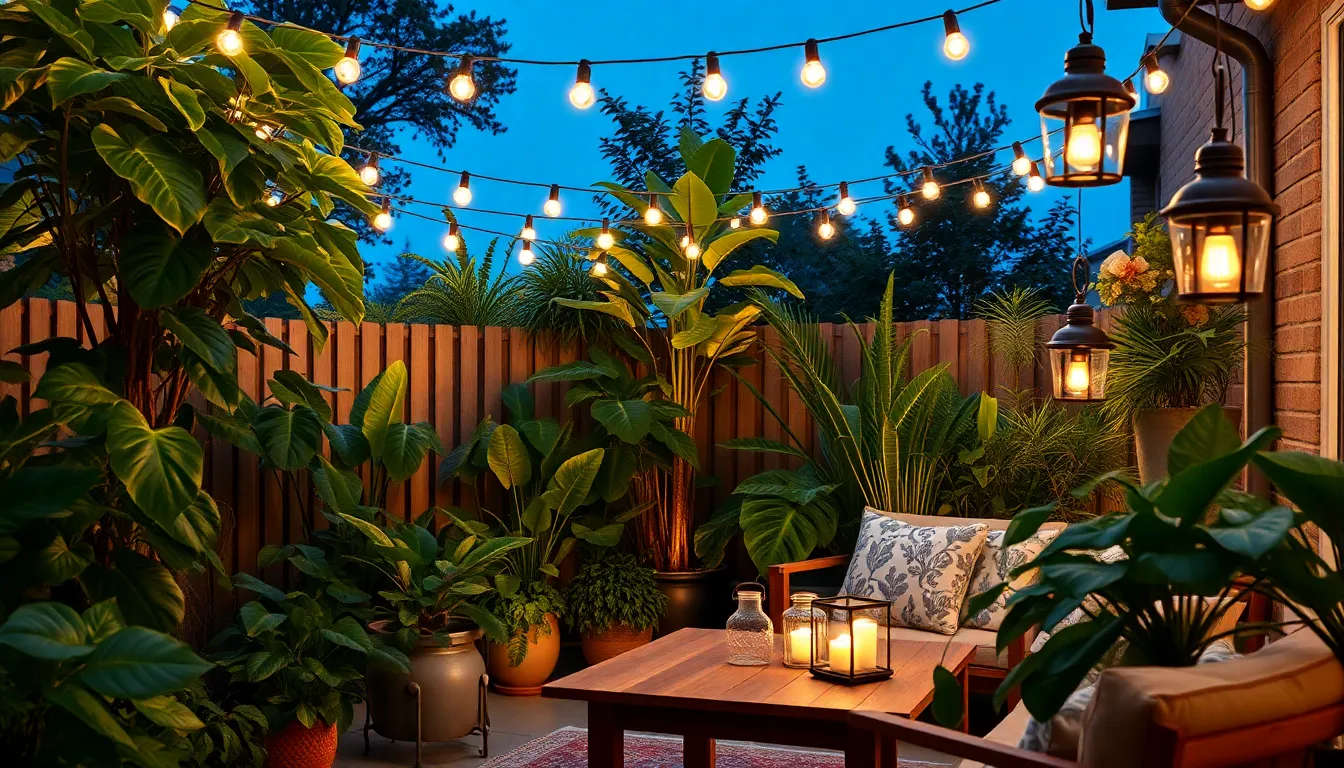
Strategic lighting transforms our outdoor houseplant displays from beautiful daytime features into captivating nighttime focal points. We can elevate our outdoor plant decor by selecting lighting answers that complement both our plants and overall design aesthetic.
Install Solar-Powered Plant Spotlights
Solar powered plant spotlights offer an energy efficient solution for highlighting our most impressive houseplants after dark. These spotlights require no electrical wiring, making them perfect for illuminating statement plants like fiddle leaf figs or large monstera positioned throughout our outdoor spaces. We can position these lights to accentuate the unique textures and architectural shapes of our tropical houseplants, creating dramatic shadows and depth. Modern solar spotlights charge during the day and automatically illuminate our plant arrangements at sunset, providing 6-8 hours of consistent lighting. Strategic placement allows us to highlight different plant heights and create visual layers that draw attention to our carefully curated outdoor plant collections.
Use String Lights to Create Ambiance
String lights add warm, inviting illumination that enhances the cozy atmosphere around our outdoor houseplant displays. We can drape these lights over pergolas, along fence lines, or through the branches of larger plants to create a magical evening environment. Warm white LED string lights complement the natural green tones of our houseplants while providing enough ambient light for evening relaxation. These lights work particularly well when woven through hanging baskets of trailing pothos or cascading plants, creating beautiful silhouettes. Solar powered string light options eliminate the need for outdoor electrical connections and can run for 8-10 hours on a full charge, making them both practical and enchanting for our outdoor plant spaces.
Add Lanterns for Functional and Decorative Appeal
Lanterns combine practical illumination with stylish design elements that enhance our outdoor houseplant decor. We can place tabletop lanterns among our container gardens or hang larger lanterns from pergola beams to create focal points that complement our plant arrangements. Solar powered lanterns eliminate cord management while providing soft, diffused lighting that doesn’t overpower our plant displays. These versatile lighting fixtures come in materials like bamboo, metal, and weather resistant plastics that coordinate with our planter selections. Pathway lanterns positioned near our larger houseplant containers help define outdoor spaces while ensuring safe navigation around our garden areas during evening hours.
Create Themed Outdoor Plant Zones
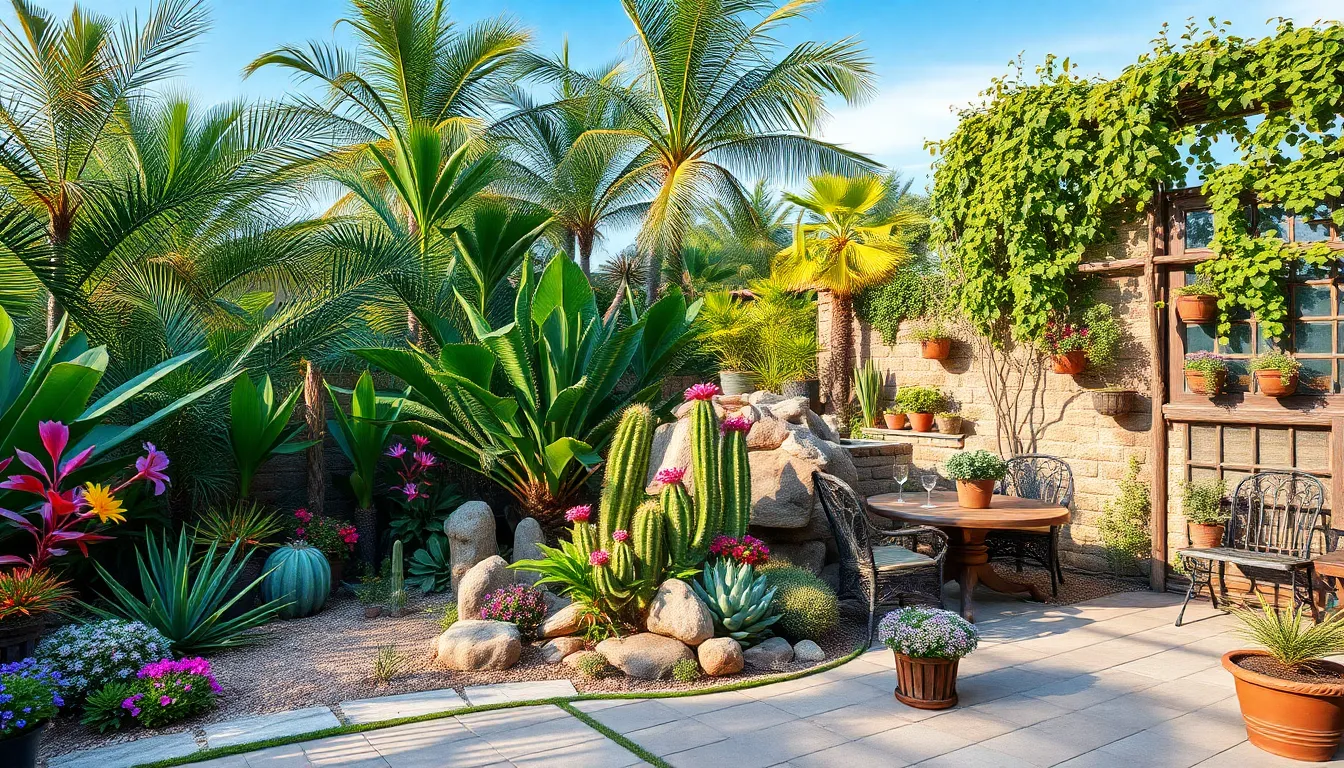
Zoning transforms outdoor spaces into distinct areas that serve exact purposes while maintaining visual coherence. Garden zones integrate various plant species, hardscaping elements, and decorative features to create atmosphere and functionality.
Design a Tropical Paradise Corner
Tropical paradise corners evoke lush, vibrant environments using plants that thrive in humid, warm conditions. We recommend selecting species like palms, ferns, and colorful flowering plants that create the exotic atmosphere you’re seeking. These zones work best when you create microclimates with shade structures and humidity sources to support tropical growth.
Bamboo fences add authentic texture while serving as natural privacy screens between zones. Water features like small fountains or misters boost humidity levels that tropical plants crave. Colorful ceramic pots in blues, greens, and terracotta tones enhance the paradise aesthetic.
Strategic lighting elevates tropical corners from day to night entertainment spaces. Warm colored lights or soft white LED strips wrapped around palm trunks create enchanting evening ambiance. Solar lanterns nestled among broad leafed plants provide functional illumination while maintaining the exotic feel.
Build a Desert Succulent Garden
Desert succulent gardens emphasize drought tolerant plants that require minimal maintenance while delivering maximum visual impact. Cacti and various succulent varieties arranged with rocks, sand, and gravel create authentic arid landscapes. These gardens thrive in sunny locations with excellent drainage systems.
Creative arrangements using different sized succulents add depth and interest to desert zones. Large barrel cacti serve as focal points while smaller echeveria and jade plants fill surrounding spaces. Stone pathways winding through succulent clusters guide visitors through the desert experience.
Decorative elements like driftwood, rustic terracotta pots, and colored sand layers complement the desert aesthetic. Metal sculptural pieces or weathered containers add artistic touches without overwhelming the natural beauty. These low maintenance zones require watering only every few weeks during growing seasons.
Establish a Cottage Garden Herb Section
Cottage garden herb sections blend practical functionality with charming aesthetics through informal design principles. These zones typically combine culinary herbs like lavender, rosemary, and thyme with edible plants such as cucumbers alongside ornamental wildflowers and hollyhocks. The informal curved bed design creates cozy, country atmospheres.
Rustic garden furniture provides functional seating while reinforcing the cottage theme throughout the space. Birdbaths attract beneficial wildlife while serving as decorative focal points among herb plantings. Pergolas or trellises support climbing herbs like oregano or nasturtiums while adding vertical interest.
Mixed plantings encourage both beauty and utility by combining fragrant herbs with colorful flowers. Lavender borders provide natural pest control while delivering soothing scents. Rosemary bushes offer year round structure while supplying fresh cooking ingredients steps from your kitchen.
Natural dividers using climbing plants such as ivy or clematis create privacy between different themed zones. These living partitions establish boundaries while maintaining the organic flow throughout your outdoor plant paradise.
Maximize Small Outdoor Spaces with Vertical Plant Displays
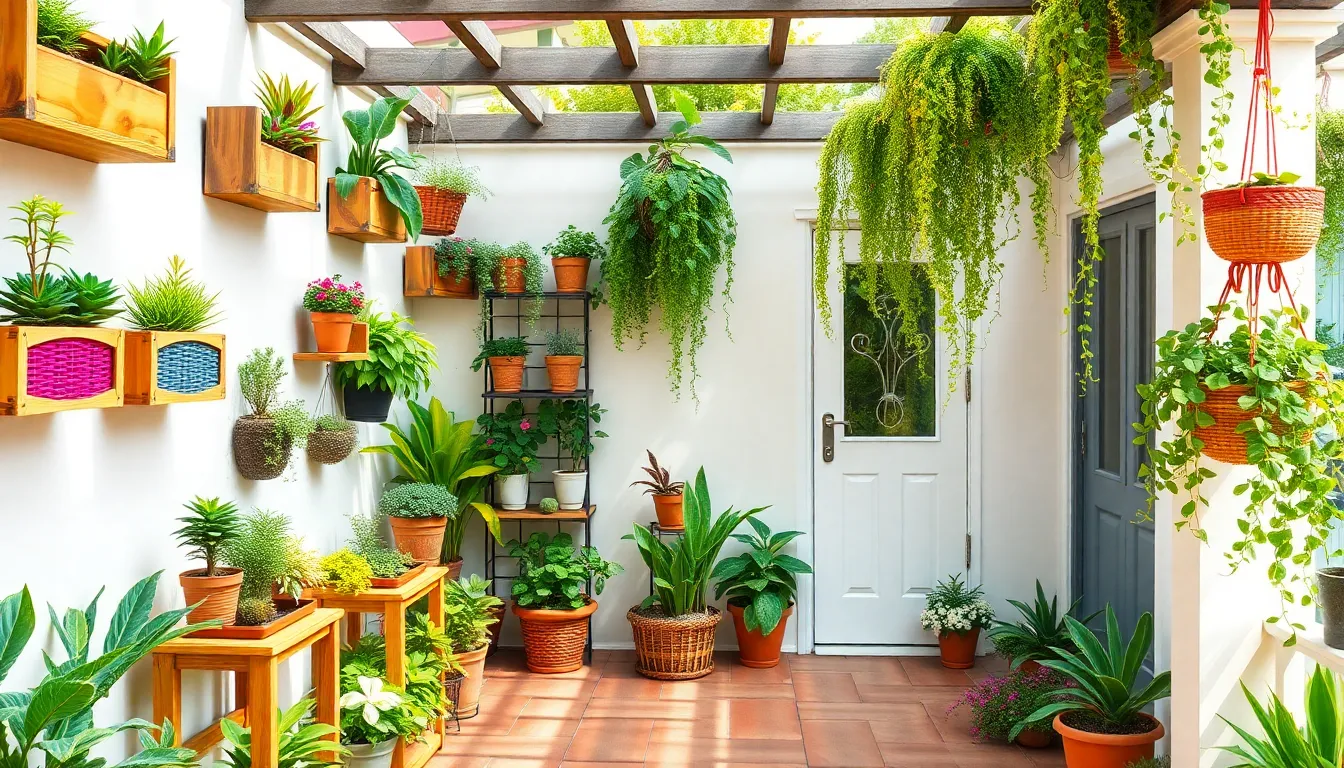
Vertical gardening transforms limited outdoor areas into lush green sanctuaries without sacrificing precious floor space. We’ll explore innovative answers that add depth and visual interest to any compact patio or balcony.
Install Wall-Mounted Planters
Wall-mounted planters create stunning living walls that frame windows and cover unsightly fences. We recommend using materials like wooden boxes, wicker baskets, or even upcycled trash bins painted in bold colors to match your outdoor aesthetic. These vertical displays work perfectly for balconies and patios where ground space is limited.
Succulents and herbs thrive in wall-mounted systems, providing both beauty and functionality. You can arrange these planters in artistic patterns to create visual interest while maximizing your growing space. Consider combining different sized planters to create a ever-changing display that draws the eye upward.
Use Tiered Plant Stands and Shelving
Tiered plant stands use vertical height instead of consuming valuable floor area. Weather-resistant wooden or metal stands double as decorative furniture pieces while supporting multiple plant containers. We find this approach particularly effective for organizing plants by size and sunlight requirements.
Shelving units allow you to create layered displays that add depth and dimension to your outdoor space. Stack multiple pots vertically to showcase different plant varieties while maintaining easy access for watering and maintenance. This method works exceptionally well for displaying collections of small potted plants or starting seedlings.
Hang Plants from Ceiling and Overhead Structures
Hanging planters suspended from ceilings, pergolas, or porch eaves add greenery overhead while freeing up ground space. Ceramic pots tied with rope, macramé hangers, and geometric planters create stunning aerial displays that enhance your outdoor environment.
Popular hanging options include globe-shaped planters perfect for air plants and small succulents. These suspended gardens draw the eye upward and add texture without cluttering walkways or seating areas. Consider incorporating water-saving moss or self-watering planters to reduce maintenance needs in your vertical displays.
Choose plants adapted to vertical environments such as trailing vines, ferns, and cascading varieties that naturally complement hanging installations. These selections add both greenery and flowing movement to your outdoor space while thriving in elevated positions.
Protect Your House Plants During Seasonal Changes
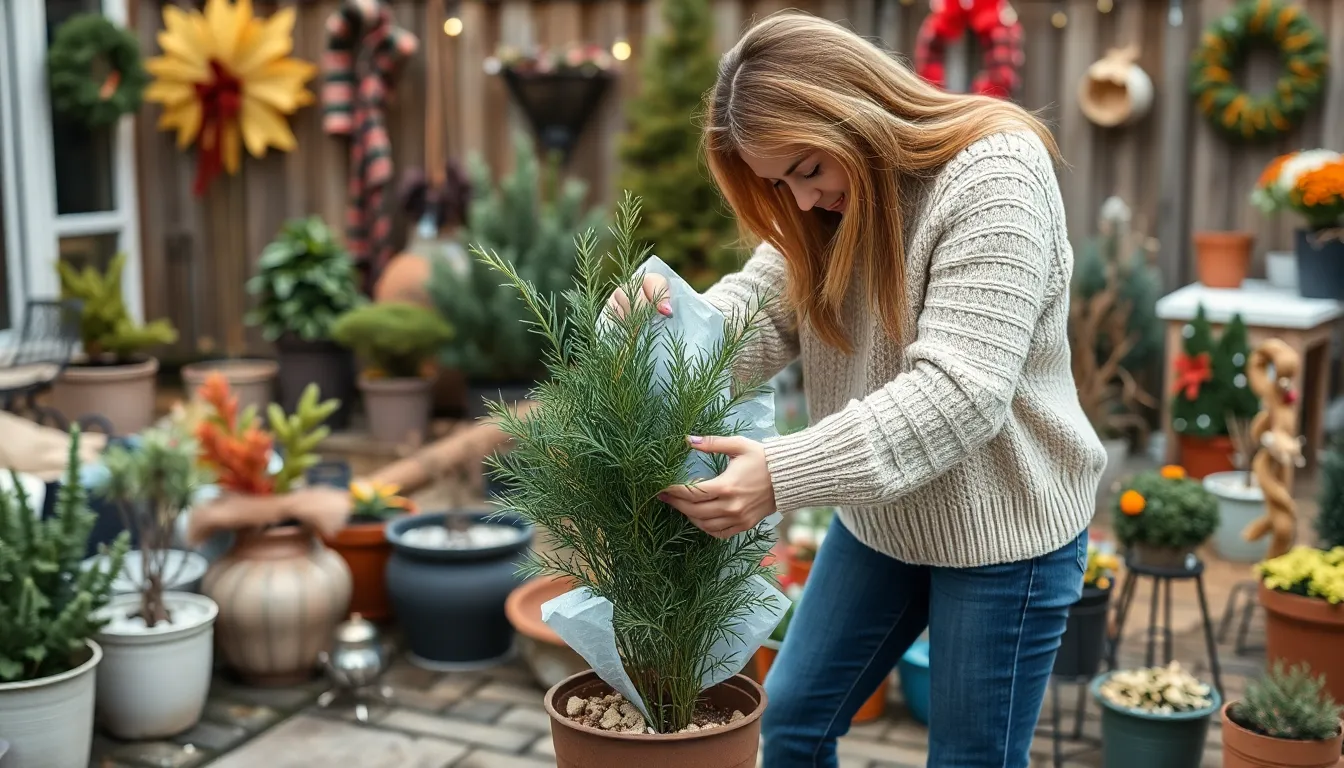
Transitioning our houseplants from outdoor summer displays to winter protection requires strategic planning to ensure their survival through harsh weather conditions. We’ll need to carry out multiple protective measures that shield plants from temperature drops, wind damage, and other seasonal challenges.
Prepare Plants for Winter Storage
Pruning becomes our first essential task when preparing houseplants for winter storage. We should cut back overgrown foliage and inspect each plant thoroughly for pest infestations before bringing them indoors. Moving plants to protected locations like garages or well-lit indoor areas helps them adjust gradually to lower light conditions and reduced watering schedules.
Container insulation protects potted plants that can’t be relocated indoors. We apply heavy mulch layers directly within containers and wrap pots with insulating materials to maintain root warmth throughout winter months. Watering techniques require adjustment during storage periods, with thorough soaking followed by complete drainage preventing salt buildup in soil.
Indoor placement demands attention to lighting and humidity requirements. We position plants near south-facing or west-facing windows where they’ll receive maximum available sunlight. Fertilizing reduces to minimal applications of water-soluble fertilizer every 4-6 weeks, allowing plants to rest during their dormant winter phase.
Create Windbreaks for Delicate Species
Windbreak construction provides essential protection for sensitive outdoor houseplants during harsh weather periods. We drive stakes into the ground around vulnerable plants and stretch burlap fabric between them, creating effective barriers against icy winds that can cause severe leaf damage and stress.
Natural windbreaks using existing industry features offer permanent protection answers. We position delicate houseplants near the southern or western sides of our homes where building structures naturally deflect cold winds. Grouping plants together creates microclimates that reduce individual plant exposure to harsh weather conditions.
Temporary shelter structures extend our protection options during extreme weather events. We use large cardboard boxes, plastic tubs, or heavy tarps to cover sensitive plants from ground level upward, trapping soil warmth that freezes more slowly than air temperatures. Holiday string lights placed under these coverings provide additional temperature elevation when frost threatens our outdoor displays.
Monitor Temperature and Humidity Levels
Temperature monitoring becomes critical for successful houseplant protection during seasonal transitions. We check weather forecasts regularly and carry out protection measures before temperatures drop below our plants’ tolerance levels. Mulching with materials like straw or pine straw provides insulation that traps air and maintains soil warmth compared to dry, unprotected ground.
Humidity management requires special attention when moving plants indoors during winter months. We group plants together to create localized humid microclimates or use household humidifiers to combat dry indoor air that typically accompanies heating systems. Indoor air humidity levels often drop significantly during winter, making supplemental moisture essential for tropical houseplants.
Cloche systems offer precise environmental control for individual plants or small groupings. We create mini greenhouse effects by inverting planters over small houseplants or constructing cold frames that shelter plants while allowing easy access for maintenance. These structures contain heat effectively and shield plants from snow accumulation while extending growing seasons for hardy species.
Integrate Outdoor Plant Decor with Existing Landscape
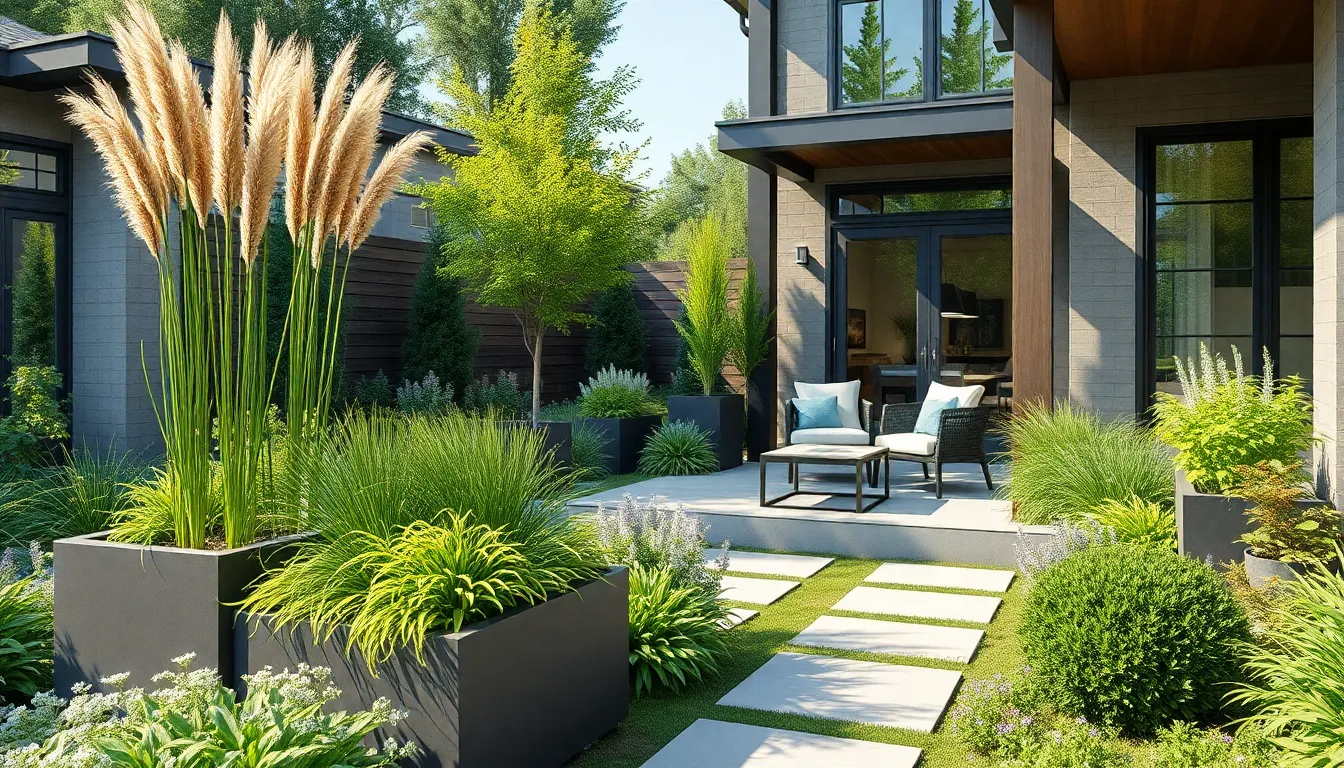
Creating a cohesive outdoor space requires thoughtful integration of plant decor with your existing industry features. We’ll show you how to harmonize your houseplant displays with the natural and architectural elements already present in your outdoor environment.
Complement Your Home’s Architectural Style
Modern homes benefit from sleek, minimalist plant arrangements that echo clean architectural lines. We recommend selecting monochromatic planters with geometric shapes and planting them with tall, slender grasses like fountain grass or sculptural plants such as agave. These choices create visual harmony between your home’s contemporary features and your outdoor plant displays.
Traditional architecture calls for classic planter styles that reflect timeless design elements. Consider using ornate ceramic pots or weathered stone containers filled with climbing plants like ivy or clematis. These selections soften structural elements such as columns and walls while maintaining the elegant character of traditional homes.
Plant scale must match your home’s proportions to achieve balanced outdoor decor. Large houses accommodate oversized planters with dramatic foliage plants, while smaller homes work better with medium sized containers and delicate textures. This proportional relationship ensures your outdoor plant decor enhances rather than overwhelms your home’s architectural presence.
Coordinate with Existing Garden Elements
Layered planting creates smooth visual transitions between different garden zones and plant heights. We suggest placing taller ornamental trees and shrubs in the background, mid height perennials and ornamental grasses in the middle section, and low growing groundcovers in the foreground. This graduated approach adds depth while maintaining visual flow throughout your industry.
Strategic planter placement adds vertical interest to complement existing industry features. Tall planters with cascading plants work beautifully alongside garden walls or fences, while stacked planters of varying sizes create ever-changing focal points near patios or walkways. These arrangements maximize both space and visual texture in your outdoor environment.
Grouping plants with similar care requirements simplifies maintenance and promotes garden health. Plants that share water, sunlight, and soil preferences naturally complement each other and create cohesive displays. This approach also ensures your outdoor plant decor remains vibrant and healthy throughout the growing season.
Use Plants to Define Outdoor Living Spaces
Plants and planters effectively outline functional areas like patios, seating zones, and pathways. We use this technique to create natural “rooms” within our outdoor spaces, establishing clear boundaries without blocking sight lines. Large planters positioned at corner points or entrance areas help define these outdoor living zones while maintaining an open, welcoming atmosphere.
Climbing plants on trellises or architectural columns create vertical boundaries that add privacy and structure. These living walls can separate dining areas from lounging spaces or screen unsightly views while adding lush greenery to your industry. The vertical element also draws the eye upward, making outdoor spaces feel larger and more ever-changing.
Pathway plantings guide movement through your outdoor space while adding visual interest. Low growing plants in linear arrangements naturally direct foot traffic, while taller specimens mark transition points between different outdoor areas. This thoughtful placement creates a sense of journey and discovery within your industry design.
Maintain Year-Round Appeal with Strategic Plant Selection
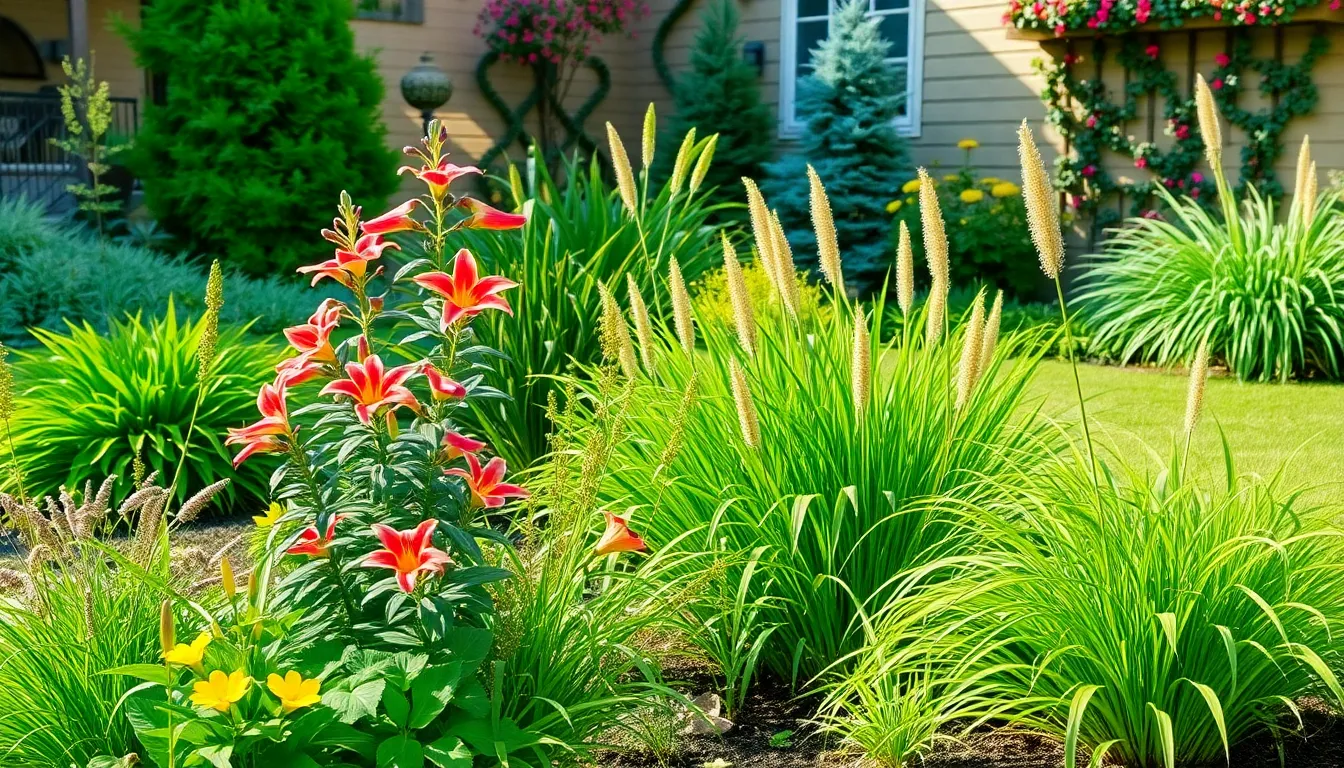
Creating captivating outdoor displays requires plants that perform beautifully across all seasons. We’ll focus on strategic combinations that ensure our outdoor house plant decor remains vibrant and captivating throughout the year.
Choose Plants with Multi-Season Interest
Multi-season performers provide changing beauty that keeps our outdoor spaces ever-changing. Coral bells (Heuchera spp.) offer colorful foliage that lasts all season while producing delicate blooms from late spring to mid-summer. These versatile plants adapt well to partial sun or shade conditions, making them perfect for various garden areas.
Foliage changes create visual excitement as seasons progress. Plants with leaves that shift colors from spring greens to autumn reds, oranges, and yellows add natural drama to our displays. We can layer these transitional plants with structural elements to create depth throughout the growing season.
Textural variety maintains visual interest even when blooms fade. Ornamental grasses, plants with distinctive bark, and those with interesting seed pods extend the appeal of our outdoor arrangements well beyond traditional flowering periods.
Plan for Continuous Blooming Cycles
Staggered bloom times ensure fresh flowers appear consistently. Daylilies (Hemerocallis spp.) serve as hardy perennials that bloom from late spring through fall, available in many colors. They thrive in full sun to partial shade while requiring minimal maintenance, making them ideal for continuous color displays.
Early bloomers kick off the growing season with vibrant displays. Spring flowering bulbs like tulips and daffodils provide initial color bursts, followed by late spring performers that bridge the gap to summer bloomers.
Summer and fall flowering plants extend the show. We can incorporate perennials and shrubs that peak during different months, creating waves of color that flow seamlessly from one season to the next. This approach ensures our outdoor house plant decor never lacks focal points.
Include Evergreen Elements for Winter Structure
Evergreens provide essential color and form when other plants go dormant. Thuja varieties like Tater Tot® and Fluffy® Western arborvitae offer year-round color and distinctive shapes suitable for foundations or borders. These plants maintain their appeal during winter months when deciduous plants lose their leaves.
Evergreen vines add vertical interest and fragrance. Star jasmine creates an evergreen vine structure with spring blooms and year-round green foliage, contributing both fragrance and visual appeal during winter months. This dual-purpose plant enhances our outdoor displays with multiple benefits.
Classic evergreen shrubs enhance curb appeal consistently. Boxwoods and hollies provide reliable structure and color that anchors our plant arrangements through every season. These dependable plants form the backbone of successful year-round outdoor house plant decor, ensuring our displays never appear empty or lifeless.
Conclusion
We’ve explored the exciting industry of transforming outdoor spaces with houseplants and discovered countless ways to create stunning displays that bridge the gap between indoor comfort and outdoor beauty. From strategic lighting and themed zones to vertical gardening answers and seasonal protection strategies these techniques offer endless possibilities for every space and style.
The key to success lies in thoughtful planning and understanding how different elements work together to create cohesive outdoor environments. Whether you’re working with a sprawling deck or a cozy balcony the principles we’ve discussed will help you maximize your space’s potential while keeping your plants healthy and thriving.
Remember that outdoor plant decor is an ongoing journey of experimentation and seasonal adaptation. As you carry out these ideas you’ll develop your own unique style and discover what works best for your exact space climate and lifestyle. Your outdoor oasis awaits – it’s time to bring those houseplants outside and watch your space transform into something truly spectacular.
Frequently Asked Questions
Can I use my houseplants as outdoor decor?
Yes, many houseplants can be successfully used as outdoor decor during warmer months. Moving houseplants outside provides them with fresh air while creating an inviting outdoor oasis. Versatile plants like snake plants, rubber trees, and tropical varieties like monstera and peace lilies adapt well to outdoor conditions and can enhance patios, decks, and balconies.
How do I create a seamless indoor-outdoor plant transition?
Create continuity by choosing plants that thrive in both environments and matching color schemes between indoor and outdoor displays. Use consistent planter materials and styles throughout both spaces. Gradually acclimate plants to outdoor conditions and select weather-resistant containers that maintain their appeal in both settings for a cohesive, harmonious flow.
What are the best plants for outdoor arrangements?
Tropical houseplants like monstera, peace lilies, and fiddle leaf figs work well outdoors. For arrangements, use a mix of tall statement plants, medium-sized varieties, and ground-cover plants to create depth. Consider plants with multi-season interest like coral bells, hardy perennials like daylilies, and evergreens for year-round appeal.
How do I protect my houseplants outdoors during seasonal changes?
Gradually acclimate plants to outdoor conditions and bring them inside before temperatures drop. Prune and inspect for pests before transitioning. Use container insulation, create windbreaks for delicate species, and monitor temperature and humidity levels. Construct temporary shelters during extreme weather and adjust watering schedules accordingly.
What containers work best for outdoor plant displays?
Choose weather-resistant materials like ceramic, stone, or fiberglass that can withstand various weather conditions. Ensure proper drainage to prevent waterlogging and fungal issues. Consider elevated planters or containers with built-in drainage systems. Balance container size and weight for seasonal mobility, with lightweight materials facilitating easier rearrangement.
How can I enhance my outdoor plants with lighting?
Use solar-powered plant spotlights to highlight impressive houseplants and create nighttime focal points. String lights add warm, inviting ambiance to plant displays. Incorporate decorative lanterns for both functional illumination and stylish design. Strategic lighting transforms beautiful daytime plant features into captivating evening displays.
What are some design tips for outdoor plant arrangements?
Layer plants by height and texture using tall, medium, and ground-cover varieties to create depth and visual interest. Use statement plants like Red Rooster Grass or Meyer Lemon trees as focal points. Incorporate seasonal color changes to keep displays dynamic. Create themed zones like tropical corners or desert succulent gardens for visual coherence.
How do I maximize small outdoor spaces with plants?
Use vertical displays with wall-mounted planters, tiered plant stands, and hanging containers to add depth without sacrificing floor space. Create living walls with wall-mounted systems and use shelving units for organized, layered displays. Hanging planters enhance overhead space and feature plants that thrive in elevated positions.
How do I integrate plant decor with my existing landscape?
Select plant arrangements that complement your home’s architectural style – sleek designs for modern homes, classic styles for traditional architecture. Consider plant scale in relation to your home’s proportions for balanced decor. Use plants to define outdoor living spaces, create natural boundaries, and guide pathways through your outdoor areas.

